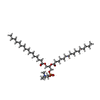+Search query
-Structure paper
| Title | Cryo-EM structure of the human Kv3.1 channel reveals gating control by the cytoplasmic T1 domain. |
|---|---|
| Journal, issue, pages | Nat Commun, Vol. 13, Issue 1, Page 4087, Year 2022 |
| Publish date | Jul 15, 2022 |
 Authors Authors | Gamma Chi / Qiansheng Liang / Akshay Sridhar / John B Cowgill / Kasim Sader / Mazdak Radjainia / Pu Qian / Pablo Castro-Hartmann / Shayla Venkaya / Nanki Kaur Singh / Gavin McKinley / Alejandra Fernandez-Cid / Shubhashish M M Mukhopadhyay / Nicola A Burgess-Brown / Lucie Delemotte / Manuel Covarrubias / Katharina L Dürr /    |
| PubMed Abstract | Kv3 channels have distinctive gating kinetics tailored for rapid repolarization in fast-spiking neurons. Malfunction of this process due to genetic variants in the KCNC1 gene causes severe epileptic ...Kv3 channels have distinctive gating kinetics tailored for rapid repolarization in fast-spiking neurons. Malfunction of this process due to genetic variants in the KCNC1 gene causes severe epileptic disorders, yet the structural determinants for the unusual gating properties remain elusive. Here, we present cryo-electron microscopy structures of the human Kv3.1a channel, revealing a unique arrangement of the cytoplasmic tetramerization domain T1 which facilitates interactions with C-terminal axonal targeting motif and key components of the gating machinery. Additional interactions between S1/S2 linker and turret domain strengthen the interface between voltage sensor and pore domain. Supported by molecular dynamics simulations, electrophysiological and mutational analyses, we identify several residues in the S4/S5 linker which influence the gating kinetics and an electrostatic interaction between acidic residues in α6 of T1 and R449 in the pore-flanking S6T helices. These findings provide insights into gating control and disease mechanisms and may guide strategies for the design of pharmaceutical drugs targeting Kv3 channels. |
 External links External links |  Nat Commun / Nat Commun /  PubMed:35840580 / PubMed:35840580 /  PubMed Central PubMed Central |
| Methods | EM (single particle) |
| Resolution | 3.1 - 3.2 Å |
| Structure data | EMDB-13416, PDB-7phh: EMDB-13417, PDB-7phi: EMDB-13418, PDB-7phk: EMDB-13419, PDB-7phl: |
| Chemicals |  ChemComp-PCF:  ChemComp-ZN:  ChemComp-K: |
| Source |
|
 Keywords Keywords |  TRANSPORT PROTEIN / Channel / TRANSPORT PROTEIN / Channel /  potassium channel / potassium channel /  tetramer / tetramer /  voltage-gated / voltage-gated /  membrane protein membrane protein |
 Movie
Movie Controller
Controller Structure viewers
Structure viewers About Yorodumi Papers
About Yorodumi Papers












